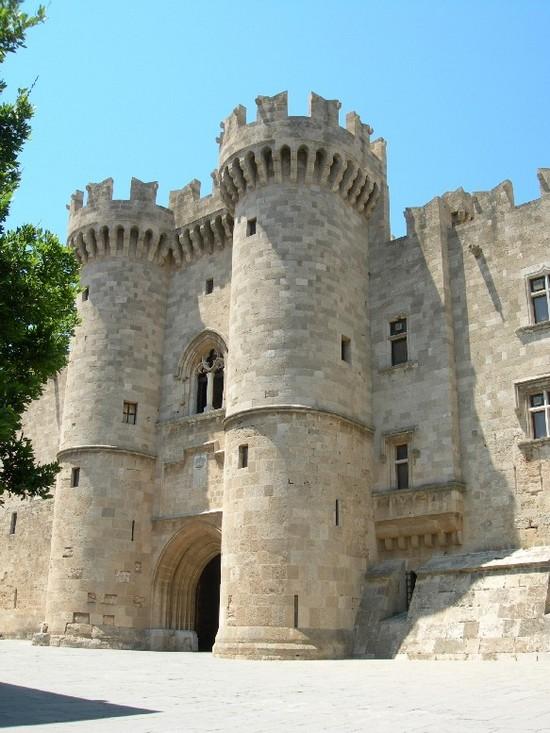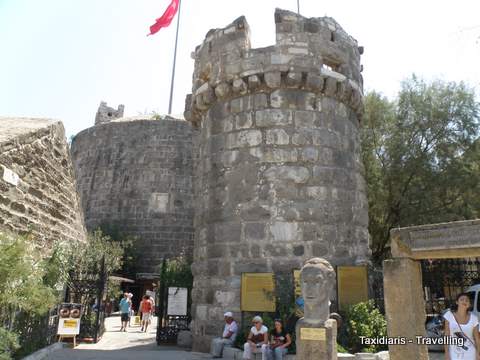Tuesday, October 12, 2010
Hospitallers part 2: The Knights of Cyprus and Rhodes (1309-1522)
A debt is still owed to the Brave Knights of the Eastern Mediterranean islands.
by Ferdinand III

The Knights of Rhodes were the successors to the Hospitallers of St. John, and were distinguished from the latter in many ways [see here for a brief summary of the Hospitallers]. After the expulsion of the Latins from the Holy Land by the Fatimid Muslims of Egypt, after their defeat at Acre in 1291, the Hospitaller order was forced to look for a new home. They found one on the island of Cyprus, conquering it in 1309. The grand master of the and reinvigorated Hospitaller Order became a de-jure temporal sovereign on the rich and strategically important island. This constituted a true ecclesiastical principality, under the nominal suzerainty of the Emperors of the East [or of Byzantium]. In actual fact Cyprus became a sovereign and Hospitaller run state.
The major change in the Hospitaller Order post-1309 was the paramountcy of its military role. The Knights of St. John were originally conceived as a hospice and infirmary association; but after their takeover of Cyprus, the Order re-focused its efforts on its military 'wing'. Knights, of the fighting variety, came to dominate the order. This character was accentuated by the fusion of the Knights of Rhodes, with the remaining Templars who were a military-only order but were destroyed for various reasons on Friday the 13th of October in 1307. Many Templars joined the Hospitallers, and the Knights of Rhodes received much in the way of landed estates, money and transferred wealth, all emanating from the destruction of the Templar order.
The Knights of St. John became the greatest and boldest of Christian 'pirates' and raiders of Muslim shipping. They were feared and loathed by the Turks and Arabs. Islamic piracy and the extraordinarily active enslavement of Christians by Muslims, was the scourge of the Mediterranean and of European commerce. Some 10 million Europeans were taken as slaves by the Muslims during the period 700 AD to 1600 AD. This is the same as the white-based transatlantic slave trading of Blacks in the early to middle modern period. Such a destruction of European life and the predations by Muslims against far superior European states necessitated a military response. The Knights on Cyprus became the front line in the increasingly feverish and bloody Mediterranean sea battles which raged for over 300 years. The St. John's Order within a generation of their takeover of Cyprus, became the most skilled of Christian seafarers, as well as the most ambitious of naval builders and innovators in naval warfare. Simply put, they transformed the battle for the Mediterranean and their destruction of Turkish shipping, trading and littoral cities, delayed and distracted the Muslim Jihad against both Eastern Europe, and the Western Mediterranean.
The Turks responded in kind. After nearly 20 years of rule on Cyprus, the inexorable weight of Turkish numbers and repeated invasions finally ejected the Knights off of the rich island. The Order found refuge on the island of Rhodes, a highly defensible, well-fortified piece of land not far from the Turkish mainland, with an excellent harbour. For almost 200 years the Knights of Rhodes would control the vast stretches of Eastern Mediterranean trade and commerce, engaging in what the Turks called 'piracy'; but what any independent analyst would call warfare in the name of self-defence. The Knights were literally surrounded by hostile Muslim navies and armies.
The Rhodian Knights possessed first class 'cruisers' and heavier ships, which preyed on the Turkish galleys and smaller vessels. The Muslims were literally, generations behind the Westerners in all matters of naval warfare and ship building technology. The Turks and Egyptians relied on slave labor [European] to power their simple galleys into battle, where they would attempt to grapple and board the enemies ships and fight a land battle on water. The Christians used sailing ships some 200 years before the Muslims would adopt the technology. This meant that slave-trading and the search for slave-labor was a very minor aspect of Rhodian naval warfare.
The opposite was true for the Muslims. The Knights' ships enjoying the advantages of technology and personnel skill, became quite audacious, descending upon the Muslim coast almost at will; and able to pillage the richest ports of the Orient, such as Smyrna (1351) and Alexandria (1365). Christian superiority at sea, vested in the small numbers of the Knights of Rhode's ships, would refract and deflect Muslim and Turkish advances westwards until the 16th century. After Constantinople fell in 1453, the sheer mass of numbers and galleys made the demise of Rhodos inevitable. Under its grand master, Pierre d'Aubusson, the Knights of Rhodes repulsed all the forces of Mahomet II in the siege of 1480. They had been outnumbered some 15:1. In 1522 Suleiman II returned to the attack with a fleet of 400 ships and an army of 140,000 men. The Rhodian Knights sustained this great onslaught with their habitual courage for a period of six months under their grand master, Villiers de l'Isle Adam, and capitulated only when their supplies were completely exhausted.
In admiration for their bravery, Suleiman II spared the lives of the remaining few Knights. He even lent them his ships to return to Europe. Once back in Italy the Knights, asked the Spanish emperor Charles V, whose empire controlled much of Italy, to grant them the island of Malta. This sovereignty was granted to the Order in 1530, and the Knights of Rhodes, became the Knights of Malta.
